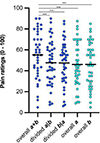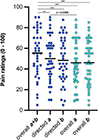Spatial Tuning in Nociceptive Processing Is Driven by Attention
- PMID: 36965648
- PMCID: PMC10330125
- DOI: 10.1016/j.jpain.2023.03.005
Spatial Tuning in Nociceptive Processing Is Driven by Attention
Abstract
When the source of nociception expands across a body area, the experience of pain increases due to the spatial integration of nociceptive information. This well-established effect is called spatial summation of pain (SSp) and has been the subject of multiple investigations. Here, we used cold-induced SSp to investigate the effect of attention on the spatial tuning of nociceptive processing. Forty pain-free volunteers (N = 40, 20 females) participated in this experiment. They took part in an SSp paradigm based on three hand immersions into cold water (5°C): Participants either immersed the radial segment ("a"), ulnar segment ("b") or both hand segments ("a+b") and provided overall pain ratings. In some trials based on "a+b" immersions, they were also asked to provide divided (ie, first pain in "a" then in "b"; or reversed) and directed attention ratings (ie, pain only in "a" or "b"). Results confirmed a clear SSp effect in which reported pain during immersions of "a" or "b" was less intense than pain during immersions of "a+b" (P < .001). Data also confirmed that spatial tuning was altered. SSp was abolished when participants provided two ratings in a divided fashion (P < .001). Furthermore, pain was significantly lower when attention was directed only to one segment ("a" OR "b") during "a+b" immersion (P < .001). We conclude that spatial tuning is dynamically driven by attention as reflected in abolished SSp. Directed attention was sufficient to focus spatial tuning and abolish SSp. Results support the role of cognitive processes such as attention in spatial tuning. PERSPECTIVE: This article presents experimental investigation of spatial tuning in pain and offers mechanistic insights of contiguous spatial summation of pain in healthy volunteers. Depending on how pain is evaluated in terms of attentional derivative (overall pain, directed, divided attention) the pain is reduced and spatial summation abolished.
Keywords: Spatial summation; Troxler fading; attentional modulation; cold pressor; pain; receptive field; spatial tuning.
Copyright © 2023 The Authors. Published by Elsevier Inc. All rights reserved.
Conflict of interest statement
Figures




References
-
- Adamczyk WM, Manthey L, Domeier C, Szikszay TM, Luedtke K: The nonlinear increase of pain in distance-based and area-based spatial summation. Pain 162:1771–80, 2021. - PubMed
-
- Adamczyk WM, Saulicz O, Saulicz E, Luedtke K: Tactile acuity (dys)function in acute nociceptive low back pain: a double-blind experiment. Pain 159:427–36, 2018. - PubMed
-
- Biurrun Manresa JA, Neziri AY, Curatolo M, Arendt-Nielsen L, Andersen OK: Reflex receptive fields are enlarged in patients with musculoskeletal low back and neck pain. Pain 154:1318–24, 2013. - PubMed
-
- Bjerre L, Andersen AT, Hagelskjær MT, Ge N, Mørch CD, Andersen OK: Dynamic tuning of human withdrawal reflex receptive fields during cognitive attention and distraction tasks. Eur J Pain 15:816–21, 2011. - PubMed
-
- Bukola IM, Paula D: The Effectiveness of Distraction as Procedural Pain Management Technique in Pediatric Oncology Patients: A Meta-analysis and Systematic Review. J Pain Symptom Manage 54:589–600.e1, 2017. - PubMed
Publication types
MeSH terms
Grants and funding
LinkOut - more resources
Full Text Sources
Medical

